Nepal is undoubtedly one of the most beautiful places on Earth. With majestic Himalayas and a diverse ecosystem, Nepal presents a perfect landscape for all nature and adventure lovers. Not only that, but Nepal also boasts a rich cultural heritage. Moreover, it also has many amazing trekking destinations. Enthusiastic trekkers from all parts of the world visit this country for unforgettable treks. Among many beautiful places and diverse trekking zones, the Annapurna region of Nepal is a renowned trekking destination. Between the Classic Annapurna Circuit Trek and the eccentric Annapurna Base Camp Trek, trekkers have a choice between two epic adventures. So, if you are looking for more information about the Annapurna Base Camp Trek vs Annapurna Circuit Trek, then look no further! This article will help you answer which to choose for your perfect Himalayan adventure by comparing two of Nepal’s most celebrated treks: Annapurna Circuit vs. Annapurna Base Camp Trek.
Among the finest trekking destinations in Nepal is the Annapurna region, which features two of its most popular trails: the Classic Annapurna Circuit and the Annapurna Base Camp Trek. Both trekking routes have high mountains and cultural richness, but the journeys taken on these two routes have characteristics that separate them from each other. The Annapurna Circuit encompasses a longer and more remote loop, traversing high mountain passes and diverse landscapes, while the Annapurna Base Camp Trek follows a shorter, more direct route into the heart of the Annapurna Sanctuary. This article offers a clear comparison to help you select the trek that best suits your schedule, experience, and expectations.
Which is longer, Annapurna Base Camp or Annapurna Circuit Trek?
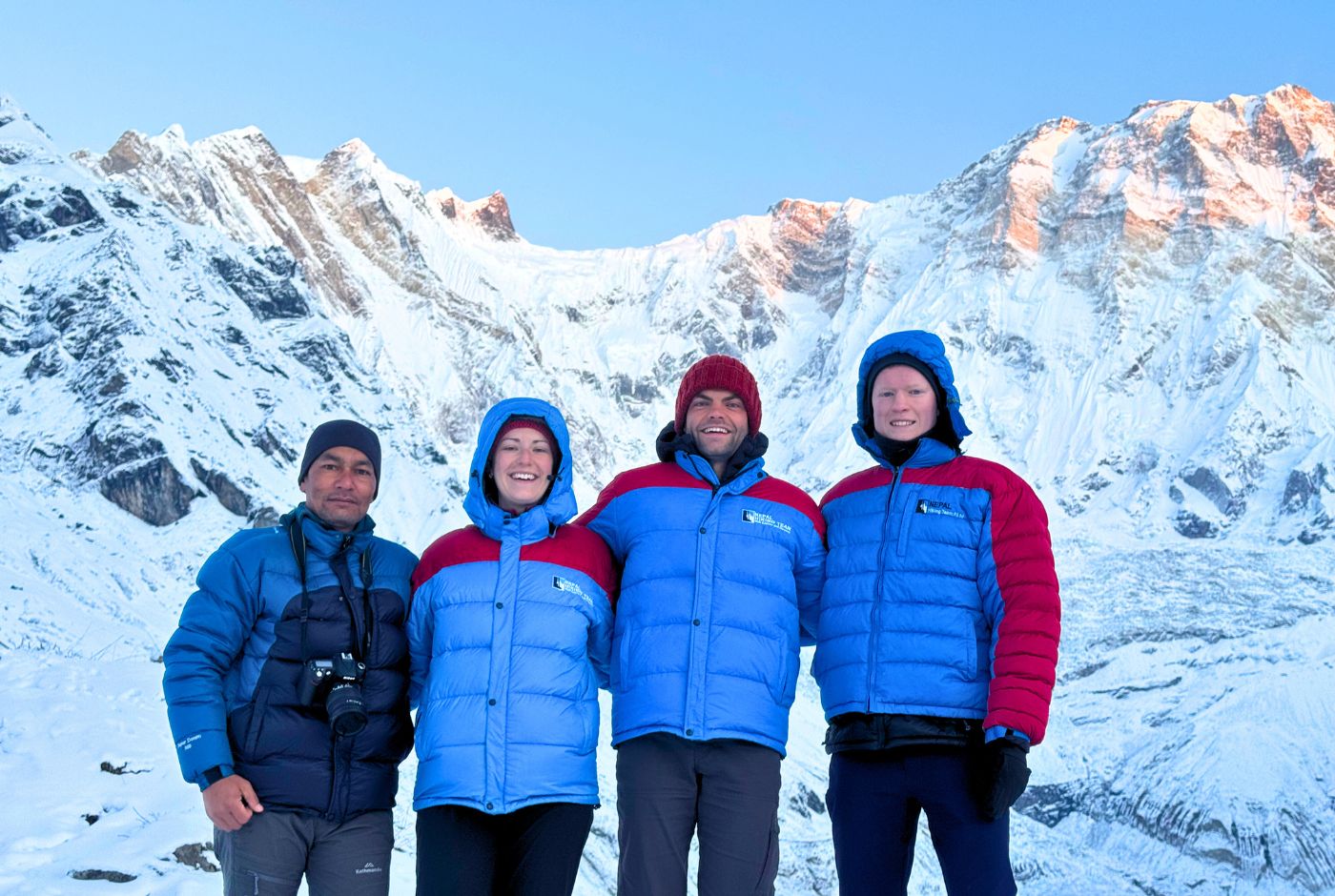
The duration of the Annapurna Circuit Trek typically ranges from 12 to 18 days, depending on the route and side trips chosen. A shorter version can be completed in about 12 days by minimizing walking time and using road transport or flights. For those adding a visit to Tilicho Lake, the trek extends to around 16 days. The classic route, which includes stops in villages such as Marpha, Tatopani, and Ghorepani, with a side hike to Poon Hill, typically takes around 18 days.
Annapurna Circuit Trek 12 - 14 days Package for 2025
The Annapurna Base Camp Trek typically ranges from 6 to 15 days, depending on the itinerary and mode of return. Trekkers with limited time often choose the 9-day heli-return option, which still offers a complete trekking experience, including the very best aerial view of the entire Annapurna region. A shortened version with flights to and from Pokhara takes around 11 days, striking a balance between efficiency and adventure. For a more relaxed pace, panoramic and luxury treks—ranging from 9 to 10 days—focus on comfort, cultural encounters, and scenic viewpoints like Ghandruk and Dhampus. Standard ABC itineraries without shortcuts generally fall between 12 and 15 days, depending on acclimatization and side trips.
Annapurna Base Camp Trek 12 - 14 days Package 2025!!!
The Annapurna Circuit Trek generally takes between 12 and 18 days, covering a wider and more diverse route. The Annapurna Base Camp Trek is a shorter journey in comparison to the Annapurna Circuit Trail and usually takes 9 to 15 days. It offers a short and more direct path into the mountain basin.
Annapurna Base Camp Trek Vs Annapurna Circuit Trek - Distance

The classic Annapurna Circuit Trek spans roughly 170–180 kilometers of hiking, which is about 106–112 miles in total for a full circuit trip. The regular Annapurna Circuit Trek for 12 to 14 days spans approximately 110-116 km (68-72 miles) in total, covering a full circuit round-trip distance.
The standard Annapurna Base Camp trek covers roughly 85–95 km (about 53–59 miles) in total round-trip. This spans the route from the trailhead at Birethanti up to Annapurna Base Camp (4,130 m) and down to the Jhinu Danda (Samrung) hot springs. A shorter 11‑day Annapurna Base Camp itinerary follows a similar route but totals only about 84–90 km (51–56 miles).
For context, the Annapurna Circuit Trek is considerably longer than many other popular treks in Nepal. The Annapurna Base Camp trek, for example, is typically about 85-95 km (53-59 miles), and even the longer route, the classic Everest Base Camp trek, is on the order of 130 km (81 miles) round-trip, which is still less than the classic Annapurna Circuit Trail of 170-180 km (106-112 miles).
Annapurna Base Camp Trek vs Annapurna Circuit Trek- Route
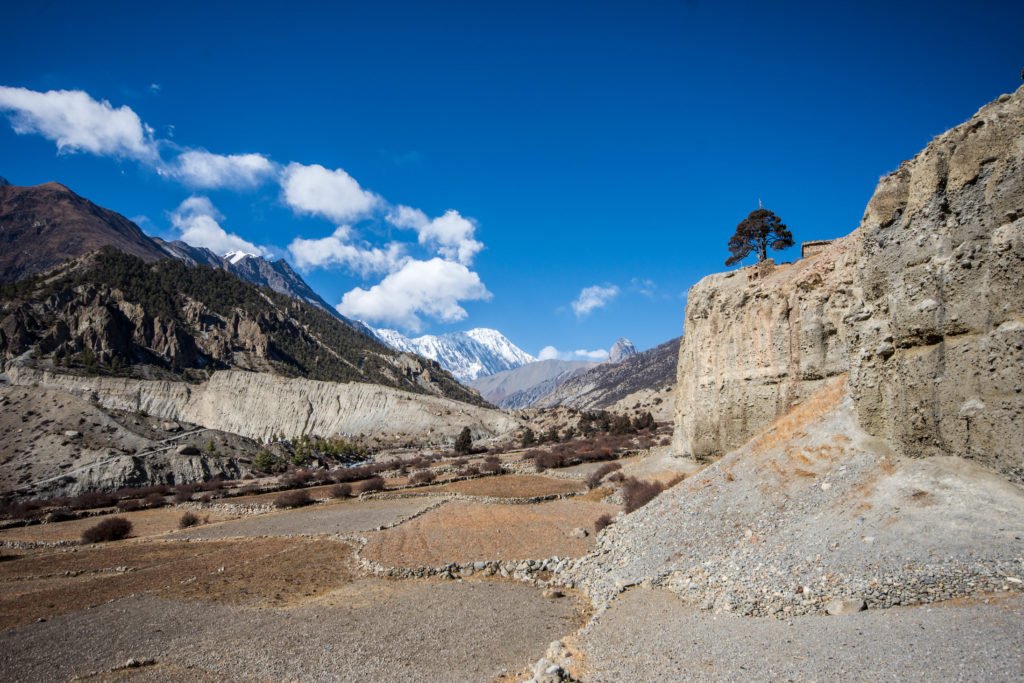
Annapurna Circuit Trek Itinerary Overview
The Annapurna Circuit Trek (the ACT Trek) showcases a diverse array of landscapes and cultures around the Annapurna Massif. It begins in Besisahar or Jagat (1,300m), where you climb the Marsyangdi River Valley and traverse villages such as Chame, Pisang, and Manang, allowing for a day of acclimatization. The trek’s most demanding section is the crossing of the Thorong La Pass (5,416m), followed by a descent to Muktinath and the striking Kali Gandaki Gorge. Then, the route takes you to Jomsom and then returns to Pokhara by flight. This 14-day Annapurna Circuit Trek offers 5–7 hours of trekking daily.
Annapurna Base Camp Trek Itinerary Overview
The Annapurna Base Camp Trek (the ABC Trek) is a straightforward, round-trip trek into the heart of the Annapurna Sanctuary. Starting at Birethani or, for some, at Nayapul near Pokhara, trekkers pass through forests, terraced farmland, and Gurung and Magar villages, including Ghandruk, Chhomrong, and Bamboo. The trail continues to Machhapuchhre Base Camp (3,700m) and then to Annapurna Base Camp (4,130m), surrounded by peaks like Annapurna I, Hiunchuli, and Machhapuchhre. Although the trek does not involve daily high mountain altitudes, a good level of fitness is still essential. This 14-day ABC Trek with Nepal Hiking Team offers an option to ascend Poon Hill. Poon Hill is renowned for its panoramic view of sunrises over the Annapurna and Dhaulagiri ranges.
Annapurna Base Camp Trek vs Annapurna Circuit Trek- Elevation
Which trek takes you to a higher altitude? Annapurna Circuit versus Annapurna Base Camp Trek
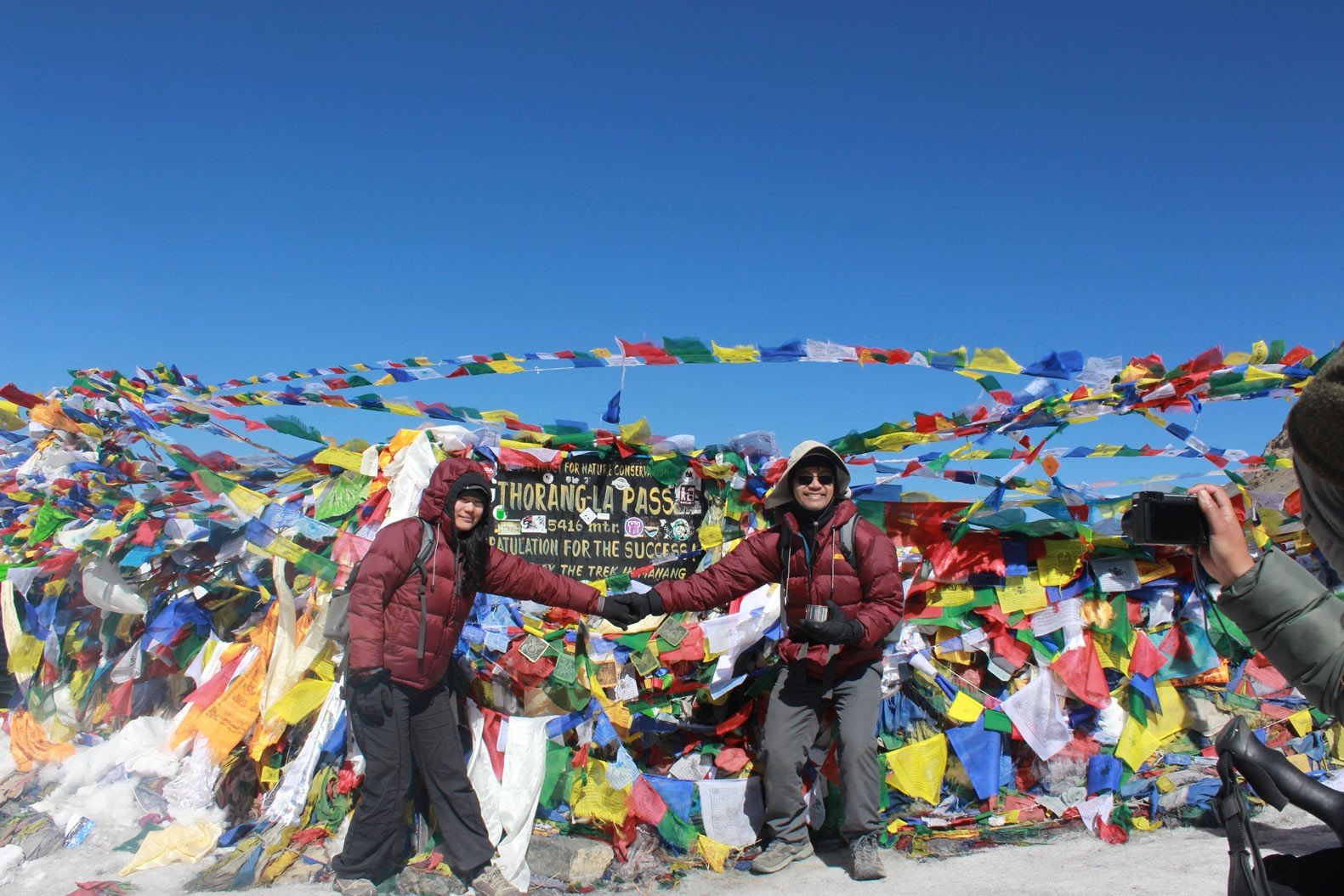
Annapurna Circuit Trek Elevation and Acclimatization
The Annapurna Circuit Trek features a steady elevation increase, peaking at Thorong La Pass (5,416 meters)—the trek’s highest and most challenging point. The ascent is distributed over several days to give the body time to acclimatize. Most itineraries include an acclimatization day in Manang (3,540 meters) as a precaution against altitude sickness. The trail continues upward through Yak Kharka (4,050m) and Thorong Phedi (4,450m) before reaching the final pass. This approach to altitude helps reduce risks and enhances safety in thinner, colder air.
Annapurna Base Camp Trek Elevation and Acclimatization
During the Annapurna Base Camp Trek, the highest elevation reached is 4,130 meters at Annapurna I’s base. Although this is lower than Thorong La, the trek still involves steady uphill hiking, particularly from Chhomrong (2,170m) through Himalaya and Machhapuchhre Base Camp (3,700m) to the final destination. There is no high pass, but proper acclimatization remains important. The trek gradually builds altitude, with optional rest stops at Bamboo, Deurali, or Chhomrong to help your body adjust. You will hike to Poon Hill (3,210m), which is often included in the ABC itinerary, to provide additional acclimatization before tackling higher terrain.
ABC Trek compared to ACT - Terrain

The Annapurna Circuit features a strikingly varied landscape, beginning with forested paths and river valleys in the lower elevations and gradually transitioning to drier, alpine terrain as altitude increases. As soon as the Thorong La Pass (5,416 m) trail creeps toward the rugged territory, steep ascents with loose scree and exposed areas will test your steadiness and endurance. The last climb to the pass will always be quite demanding and requires physical fitness preparation.
The Annapurna Base Camp trek begins on wide forest paths and riverside paths and climbs into alpine meadows and glacial moraine. Compared with the broader, high‑pass crossings of the Circuit, the ABC route is more contained within the Annapurna Sanctuary’s steep valley walls. After Machhapuchhre Base Camp, the trail continues to narrow and become increasingly rugged, with loose stones and snowfields dotting the landscape. Unlike Thorong La, there is no multi-day high pass; however, the final climb toward Base Camp entails sustained elevation gain over uneven, treacherous terrain, where good footwork and a steady pace are required.
Difficulty Level: Who Can Handle Which Route?
Which trek is easier – Annapurna Circuit or Annapurna Base Camp?
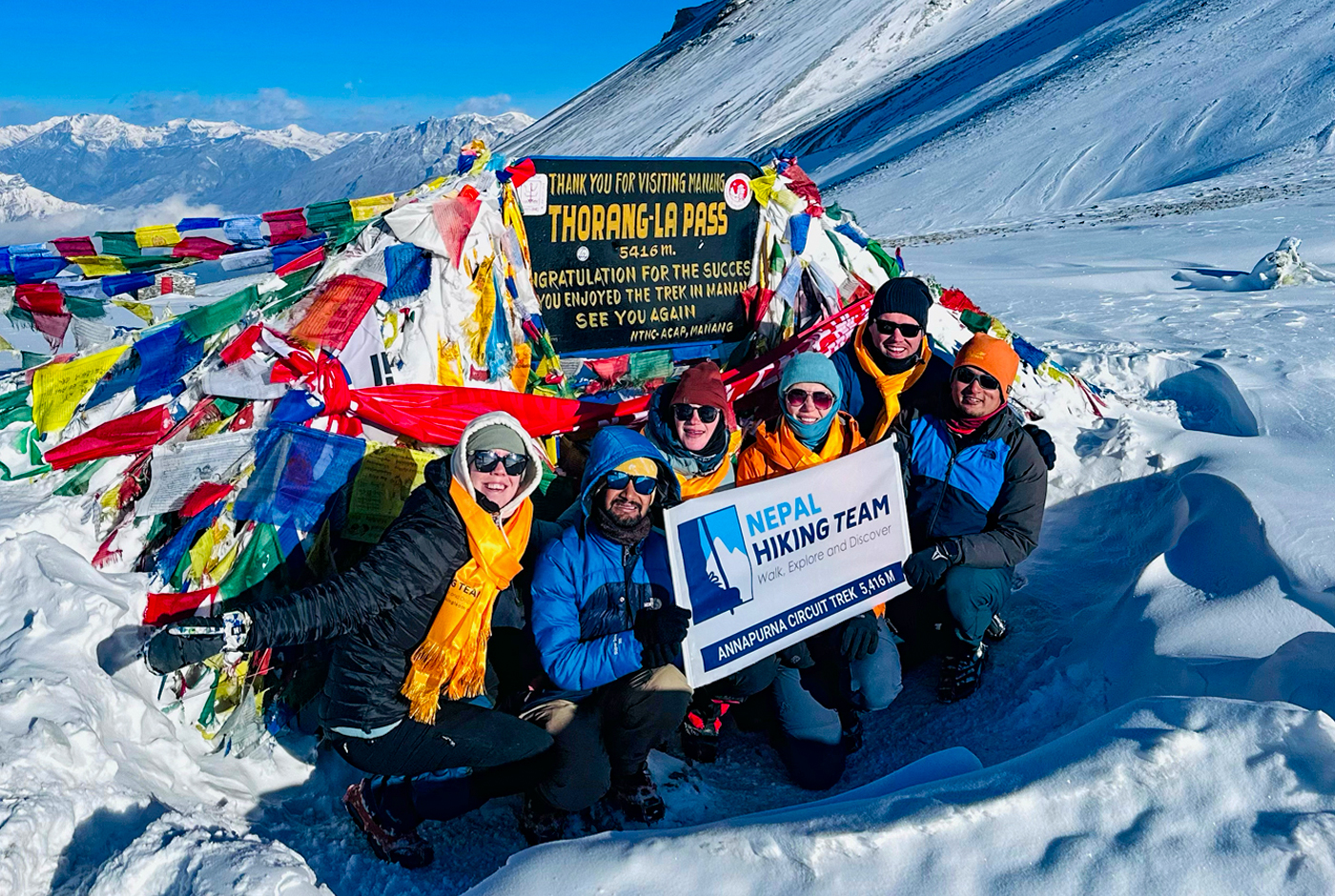
While both treks require a reasonable level of fitness, the key difference is that the Annapurna Circuit is a longer, more challenging trek that circles the Himalayas and crosses higher elevations. Whereas the Annapurna Base Camp Trek is shorter and focuses on reaching the base camp. The ACT covers about 113 km over 10–11 days with steep ascents and peaks at Thoroong La Pass (5,416 m). The ABC trek is approximately 84–94 km long, spanning 7–10 days, with a peak elevation of 4,130m, making it more beginner-friendly.
ACT requires more preparation and acclimatization due to higher elevations than the ABC trek. Though there are certain difficulties, ABC is not too difficult since it is easy enough for a large variety of trekkers, from families with kids to seniors, owing to the low risks of altitude. Both treks involve 6-8 hours of daily walking and require both fitness and mental stamina.
If you're seeking a longer, high-altitude adventure and have some trekking experience, the Annapurna Circuit Trek is the ideal choice. But if you're less experienced and short on time, yet still want a rewarding and manageable trek, the Annapurna Base Camp Trek is a great option. The Annapurna Base Camp trek has more offerings. Both promise unforgettable Himalayan experiences—just tailor your choice to your fitness, time, and trekking goals.
Annapurna Base Camp Trek vs Annapurna Circuit Trek- Highlights
Which offers the best mountain views, Annapurna Circuit or Annapurna Base Camp?
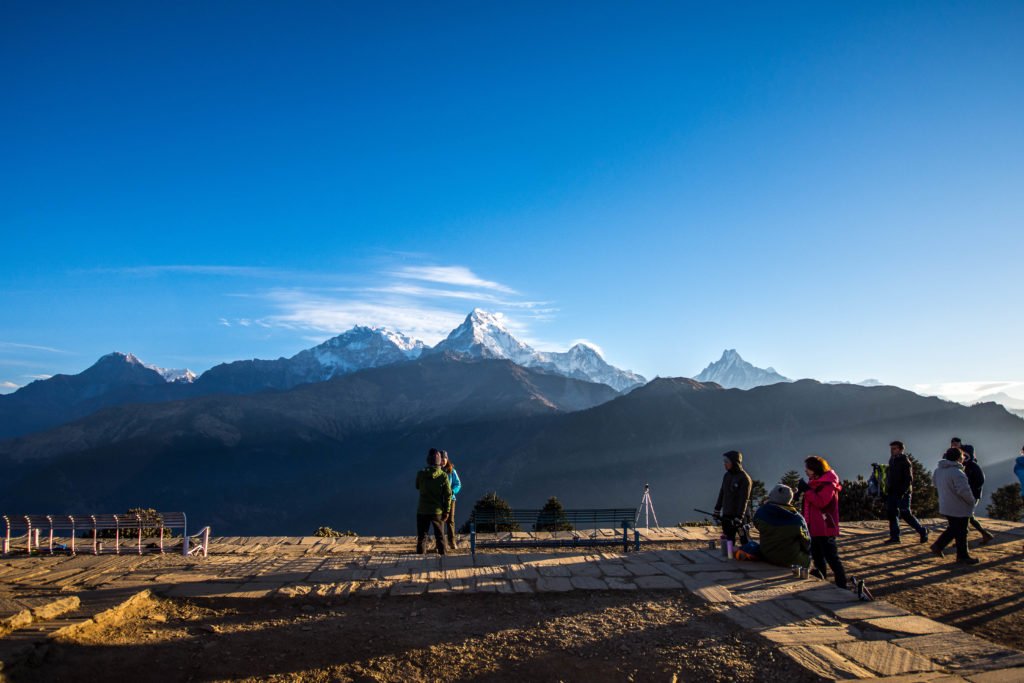
Annapurna Circuit: Diverse Landscapes and Deep Cultural Encounters.
The Annapurna Circuit Trek offers the best of changing landscapes and cultures from Nepal's most diverse regions. Leaving from grassy subtropical lowlands, the track follows the Marsyangdi River Valley and continues climbing through dense pine forests and alpine meadows before reaching the stunning high-altitude desert of the Manang region. One of the remarkable features of the trek is the sudden change from green hills to barren, windswept lands.
After Thorong La Pass (5,416m), the extensive vista over the Annapurna and Dhaulagiri massifs greets the trekkers. The trekkers will pass through the traditionally established villages of Gurung, Thakalis, and Manangis. You will visit the Muktinath Temple, which is one of the most notable pilgrimage sites for Hindus and Buddhists. Also, the medieval settlement of Kagbeni shows signs of Tibetan architectural styles and customs.
Annapurna Base Camp: Alpine Beauty and Warm Mountain Culture
Although the Annapurna Base Camp Trek covers a smaller area, it offers impressive scenery and rewarding experiences. The route leads through forests of rhododendron and bamboo, terraced fields, and into the alpine Annapurna Sanctuary, a high glacial basin surrounded by mountains. Poon Hill (3,210 m), a favorite spot on the trek, is popular for spectacular sunrise views over the Annapurna and Dhaulagiri ranges. From Chhomrong ascending to Bamboo and Machhapuchhre Base Camp, trekkers enjoy close-up views of notable peaks, including the sacred Machhapuchhre (Fishtail). Reaching Annapurna Base Camp (4,130 m) among the surrounding mountains brings a strong sense of accomplishment. Cultural experiences include visits to Gurung villages, renowned for their hospitality.
Which trek is costlier – Annapurna Circuit or Annapurna Base Camp?
Budget is a key consideration when planning a trek, and understanding how costs differ can help you choose the right route. While both treks lie within the Annapurna region, there are slight cost changes as the altitude rises.
In general, the Annapurna Circuit Trek is slightly costlier than the Annapurna Base Camp Trek. The Circuit covers a longer distance, involves more days on the trail, and often requires additional transportation—such as jeep rides to Jagat and a flight or long drive from Jomsom back to Pokhara.
Food and accommodation costs also rise as you go higher on the Circuit, especially in remote areas like Yak Kharka or Thorong Phedi, where supplies are harder to deliver. With the longer duration comes increased expenses on meals, permits, and even a few more nights in teahouses, given the increased number of days the trekkers will spend walking.
Conversely, the ABC trek is a shorter and more accessible trek. The trail goes through villages that are quite well-connected with relatively easier logistics and transportation, which helps keep costs lower. ABC is a cheaper option for trekkers with tighter budgets or limited time.
ABC Trek or Annapurna Circuit Trek- Which one is more accessible?
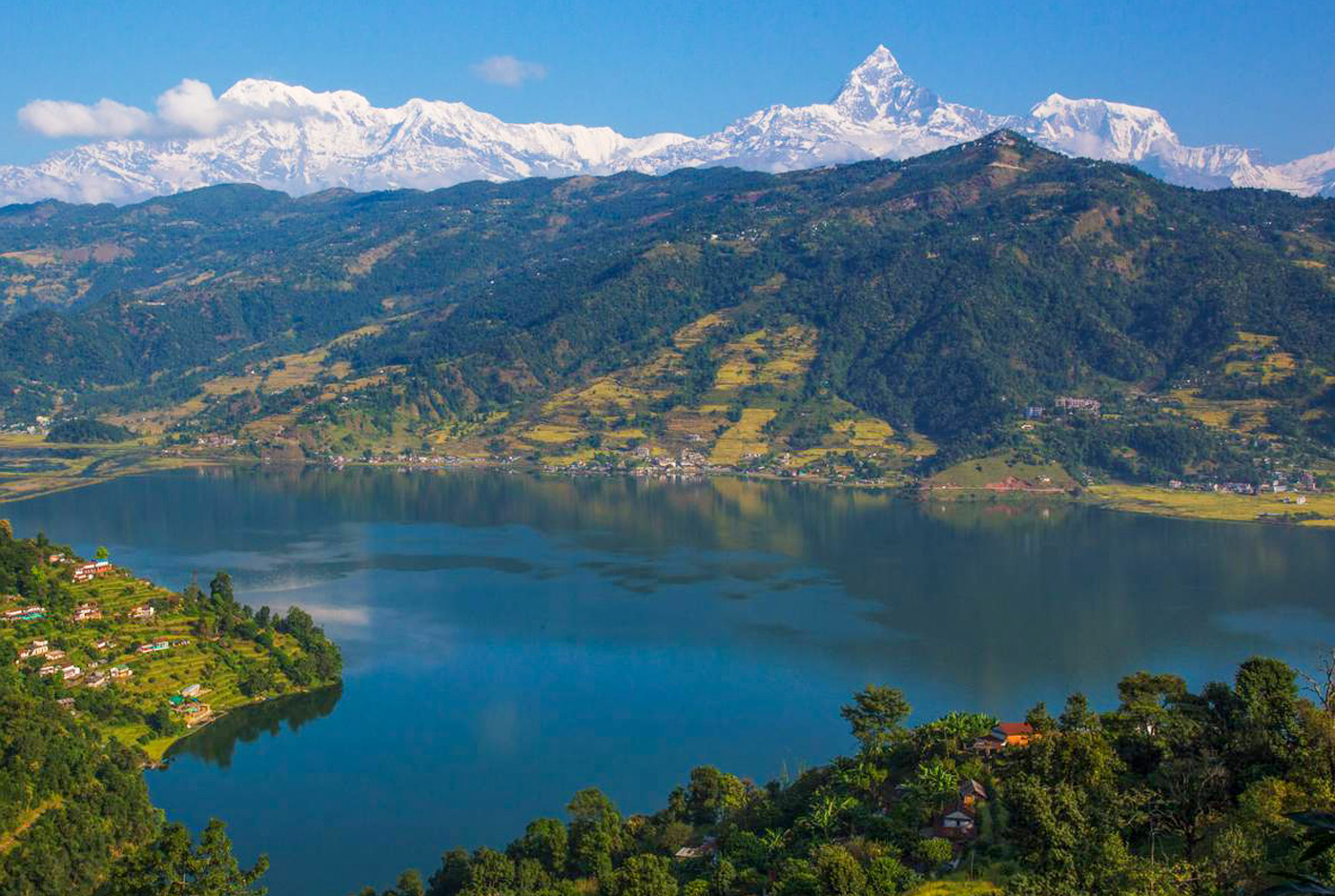
Both treks begin with an organized transfer from Kathmandu: the Circuit starts at Jagat after an 8–9-hour jeep ride over winding mountain roads, while the ABC trek begins at Birethanti following a 6–7-hour bus ride to Pokhara plus a short jeep leg. On the trail, ABC offers a well-graded path and gentler altitude gains, making it ideal for first‑time trekkers, whereas the Circuit involves longer days, a high pass at 5,416 m, and more remote sections—though all transport, permits, and lodge arrangements are fully handled by Nepal Hiking Team.
Best Time to Trek for Annapurna Base Camp and Annapurna Circuit
What is the best time to trek to Annapurna Circuit and Annapurna Base Camp?

Both the Annapurna Circuit and Annapurna Base Camp treks are best enjoyed in spring (March to May) and autumn (September to November) when the weather is stable and mountain views are at their clearest.
For the Annapurna Circuit Trek, early spring brings blooming rhododendron forests, while late autumn offers dry conditions and stunning visibility across high passes. However, the monsoon season (June–August) makes the trail slippery and the Thorong La Pass risky due to landslides and poor visibility. In winter, heavy snowfall often blocks the pass entirely.
The ABC Trek also thrives in the same peak seasons, especially with sunrise views from Poon Hill on clear mornings. While the monsoon makes the trail lush and green, it’s also muddy and leech-prone. Winter is quieter and crisp, but snow may cause limited teahouse availability, particularly above Chhomrong.
Practical Considerations & Gear
Gear and Packing Tips
The Annapurna Circuit Trek reaches high altitudes and features sections where trekking takes place through snow and ice, such as near Thorong La Pass at 5,416m. When following the above recommendations, trekkers should consider taking microspikes or crampons, a four-season sleeping bag, and a heavier down jacket to stay warmer at higher elevations. In contrast, the Annapurna Base Camp Trek has its highest point at 4,130m, which requires lighter layers, typically a three-season sleeping bag, and trekking poles for the stone stair ascents near Chhomrong and Deurali.
Accommodation
Both treks offer accommodation in local teahouses (basic lodges that provide food and a place to sleep), which provide basic twin-sharing or dormitory rooms, often with shared bathrooms. Meals are simple yet nourishing—expect plenty of dal bhat (a staple Nepali dish consisting of rice and lentil soup), noodles, soups, and tea. The ABC trail has more established stops, while higher regions on the Circuit, particularly past Manang, have more limited options but still maintain comfort and safety standards.
Internet and Connectivity
Which has greater internet connectivity? Annapurna Circuit vs. Annapurna Base Camp
Wi-Fi is available for purchase in most of the popular villages along both routes. In general, the cost of Wi-Fi ranges between NPR 200-300 (approx. USD 1.5-2) per device and is accessible wherever you stay. However, as travelers venture beyond the Manang region on the Annapurna Circuit trail, it is wise to prepare everything independently in case charging ports and internet access is unavailable. In the ABC region, connectivity is slightly more consistent, particularly in villages such as Chhomrong and Ghandruk.
Permits and Travel Insurance
Both treks require the Annapurna Conservation Area Permit (ACAP) and the Trekkers' Information Management System (TIMS) (not necessary for 2025) card. Additionally, comprehensive travel insurance that covers high-altitude trekking and emergency helicopter evacuation, especially for those venturing into the higher elevations of the Annapurna Circuit Trek.
Who Should Choose Which Trek in 2025?
Which trek is easier – Annapurna Base Camp or Annapurna Circuit?
For Beginners, Families, and Casual Trekkers:
The Annapurna Base Camp trek is generally regarded as one of the finest trekking destinations in Nepal. Although being at an altitude of 4130 m, the whole ABC trek provides the trekkers with the most flexible timing and acclimatization and shall range from 8 to 15 days, making it manageable for children and seniors alike.
For Seasoned Trekkers and Adventure Seekers:
The Annapurna Circuit Trek is what you're looking for if you want to experience a longer trek and get your adventuring done in a more adventurous manner. It is especially fit for trekkers who have experience in high-altitude trekking because the route is tough and the altitude varies. Most itineraries span between 12 and 18 days.
For Travelers with Limited Time:
If time is a concern, there's no need to worry—both routes offer shorter trekking options. After carefully considering all the factors, the Nepal Hiking Team has prepared a 12-day Annapurna Circuit Short Trek.
For a shorter ABC trek, spanning around 6–8 days, it offers an optional combination of a challenging trek and a luxurious helicopter ride to Annapurna Base Camp.
Conclusion: Annapurna Circuit vs. Annapurna Base Camp Trek
Both the Annapurna Circuit and Annapurna Base Camp treks promise an unforgettable journey through Nepal’s majestic Himalayan area, but they cater to different ambitions. If you’re a confident trekker with time on your side and a taste for high passes, remote valleys, and varied terrain, the 12–18‑day Annapurna Circuit will challenge and reward you in equal measure. If you prefer a shorter, more focused expedition—one that still delivers close‑up views of towering peaks, teahouse hospitality, and manageable elevations—the 6–10‑day Annapurna Base Camp route is your best bet. Consider your fitness level, schedule, and appetite for altitude, then choose the path that aligns with your goals—and prepare yourself for the thrill of waking each morning to Himalayan splendor.



Post a Comment